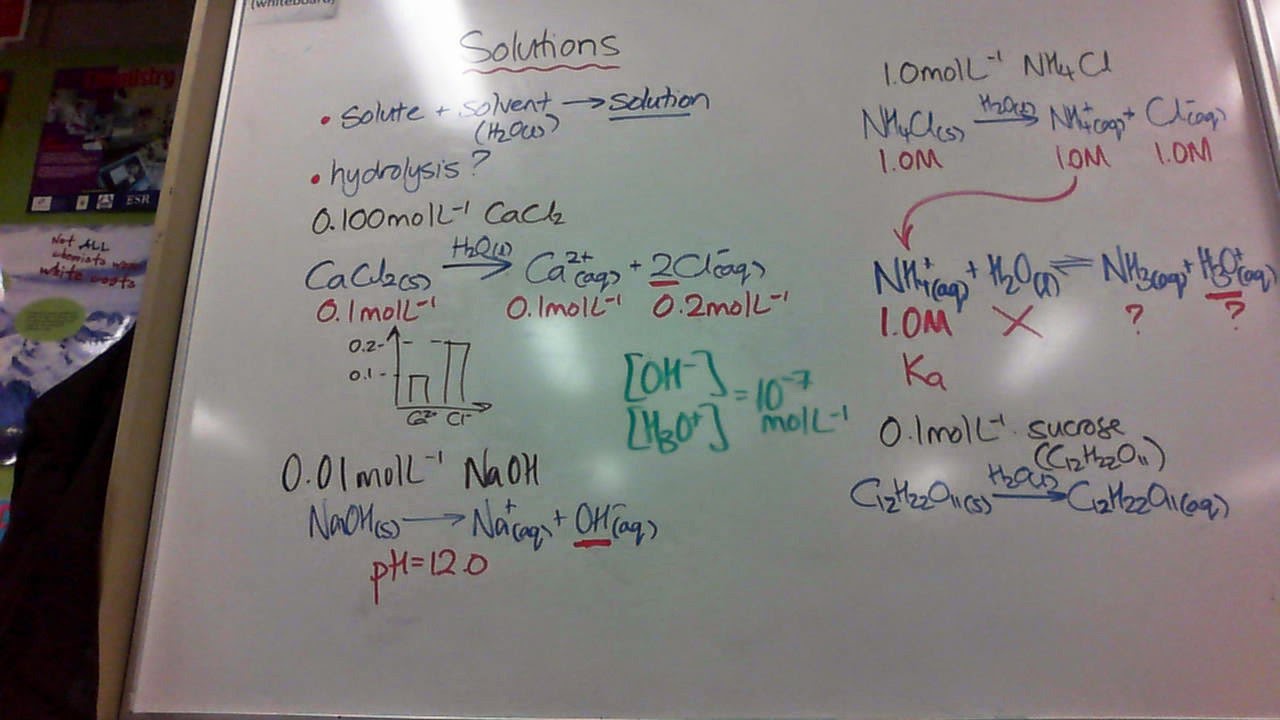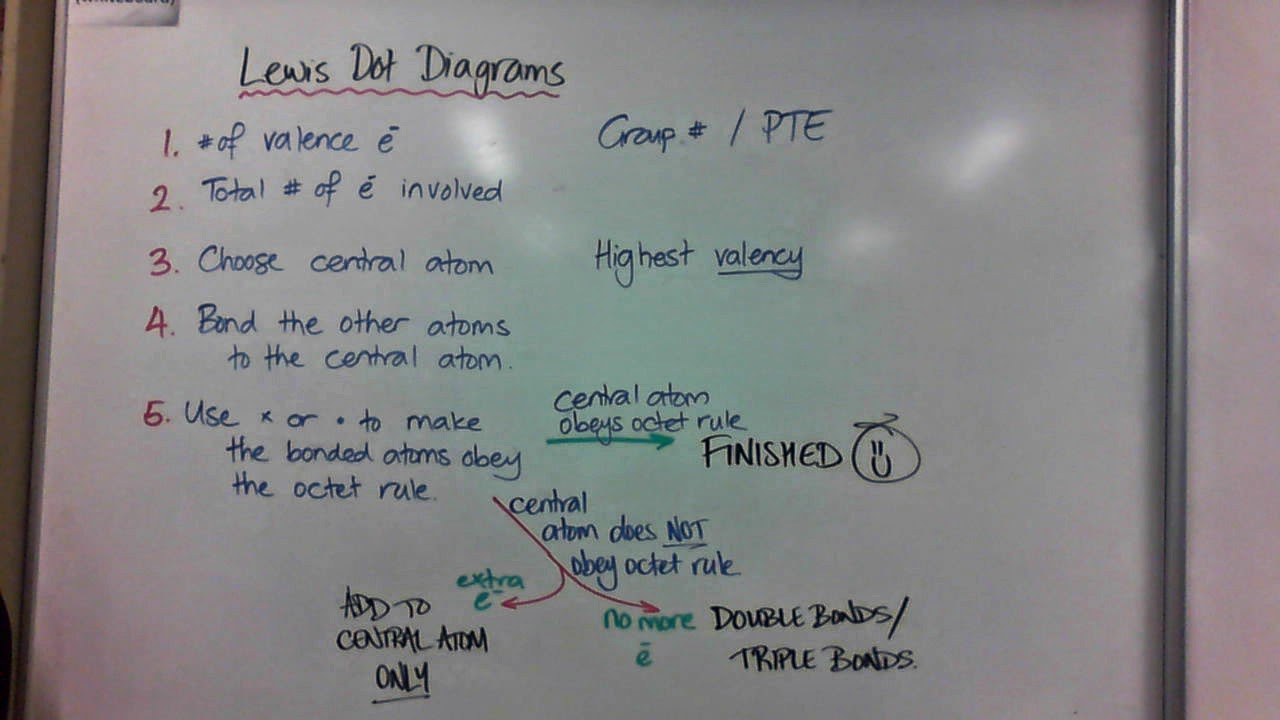Thursday, 16 October 2014
Buffers
If we think of buffers as solutions made up of weak acids and their respective conjugate bases, these are not much harder than working with weak acids. The only real difference is that we know the (desired) pH, so know the H3O+ ion concentration. Also, [H3O+] is not equal to [conjugate base] in the Ka expression.
Tuesday, 14 October 2014
Equivalence Point
This is a very tough concept to get started on, but not too tough once you work out the concentration of the salt made at the equivalence point.
This video is very long, so it may be worth having a past exam question handy and regularly using the pause button:
This video is very long, so it may be worth having a past exam question handy and regularly using the pause button:
Friday, 19 September 2014
Sketching Titration Curves
These look daunting, but it isn't actually very hard to get the general shape correct. We used a weak acid vs. strong base example:
Thursday, 18 September 2014
Titration Curves - Introduction
This was a whirlwind introduction to Titration Curves. Tomorrow, we will look at the calculations to determine the initial and final pH. Next term, we will look at how to calculate equivalence point volume and pH, and in the buffer region.
Tuesday, 16 September 2014
pH of Weak Acids
This is a very difficult concept. Every student should be able to write a hydrolysis equation, base dissociation expression (KB), and calculate KB from pKA or KA (provided in the question). Beyond that, it will take a lot of practice:
Thursday, 11 September 2014
Weak Acids
It is a bit trickier to calculate the pH of a weak acid. This is because they only partially dissociate. However, this means that these acids have an equilibrium constant (called the acid dissociation constant), which can be used to calculate the hydronium ion concentration:
The process for doing this is:
- Write the balanced equation for the dissociation with water.
- Write the acid dissociation expression.
- Substitute and solve
- [hydronium] = [conjugate base] = x
- [acid] = original concentration stated in the question (only partially dissociated)
- Calculate pH
Wednesday, 10 September 2014
Friday, 29 August 2014
Solubility and Solubility Product
The dissolving of a sparingly soluble solute can be represented by an equilibrium equation:
As this is an equilibrium, we can write an equilibrium expression, called the Solubility Product:
Solubility is usually expressed in one of two units: grams per litre (g L-1); or moles per litre (mol L-1).
We can use the solubility of a solute to calculate the Solubility Product, and use the the Solubility Product to calculate the solubility of a solute. Once we master these two skills, we have a good understanding of solubility.
The smaller the Solubility Product, the less soluble a solute is.
We can use the solubility of a solute to calculate the Solubility Product, and use the the Solubility Product to calculate the solubility of a solute. Once we master these two skills, we have a good understanding of solubility.
Ionic Product and The Common Ion Effect
Ionic Product is the same as Solubility Product, but when two solutions (of known concentration) are combined and the ions may form a precipitate. If Ionic Product is larger than Solubility Product, a precipitate does form. If they are equal, it is a saturated solution. If Solubility Product is larger, no precipitate will form.
Thursday, 28 August 2014
Aqueous Solutions Introduction - Species in Solution
This entire unit is about things dissolved in water - aqueous solutions. If they are not dissolved in water, we do not have to consider them (too much).
The examples we need to work through by tomorrow are:
We also did a brief experiment to show why some salts are alkaliine or acidic:
Wednesday, 13 August 2014
Organic Chemistry Revision
We made hexagons to represent every functional group we studied in Organic Chemistry earlier in the year:
We are putting brief study notes on the back of these, and playing a few revision games with them:
Wednesday, 30 July 2014
Practical Electrochemistry
Today, we made some half-cells and combined them with a salt-bridge and a voltmeter. Then, we were asked to make sense of our observations.
Tuesday, 29 July 2014
Standard Electrode Potentials and EMF
This is a big idea and we will spend the rest of the week exploring it:
- What are standard electrode potentials?
- How are they used to find the EMF of a cell?
- What happens if a cell has a negative EMF?
- How can EMF be used to predict what would be observed in a redox reaction?
- How can standard electrode potentials be used to rank oxidant- and reductant-strength?
Friday, 25 July 2014
Electrochemical Cells - Introduction
We started the lesson by making an electrochemical cell using zinc chloride, a zinc electrode, copper (II) sulfate, a copper electrode. We found that this generated about 1.4V
Thursday, 24 July 2014
Electrolysis
Electricity can be used to split compounds up into their elements. This is an example of oxidation-reduction.
Thursday, 3 July 2014
Wednesday, 2 July 2014
Balancing Redox Half Equations
Another recap of Level 2 work...
Thanks to Sam for finding these FLASH CARDS
Logan found these FLASH CARDS which are also excellent.
Tuesday, 1 July 2014
Monday, 23 June 2014
Friday, 20 June 2014
Entropy and Gibb's Free Energy
I had a shocker trying to explain this. This video does a much better job:
Wednesday, 18 June 2014
Hess' Law
After some debate about whether it should be Hess's Law or Hess' Law, we tried to get our head around this complicated concept:
Tuesday, 17 June 2014
Tuesday, 3 June 2014
Forces Between Particles
We started by looking at the types of solid we encountered last year. Then we focused on the forces between molecules. Last year, we called them "inter-molecular forces" but we need to be more specific this year.
Friday, 30 May 2014
Polarity
This is only slightly more complicated due to the molecules/ions with 5 (or 6) regions of electron density around the central atom.
Wednesday, 28 May 2014
Shapes of Molecules
Friday, 23 May 2014
Lewis Dot Diagrams
We started with a recap of Level 2 Chemistry:
Then, we learned about some examples which break the Octet Rule:
Then, we learned about some examples which break the Octet Rule:
Finally, we learned about how to do Lewis Dot Diagrams for polyatomic ions:
Today was #PinkShirtDay in NZ; a day to raise awareness of, and express intolerance for bullying. #StopBullying
Thursday, 22 May 2014
Electronegativity
Today was primarily a recap of Level 2 work. However, as well as knowing how to use E.N. to predict bond type, we also need to remember two trends and to justify them using our knowledge of atomic structure.
Below is the video of the key considerations being summarised for the class in 2013:
Below is the video of the key considerations being summarised for the class in 2013:
Friday, 16 May 2014
Transition Metals
Transition metals have some characteristic properties. We need to be able to explain these in terms of their atomic structure (radius and/or electron configuration).
Thursday, 15 May 2014
Ionisation Energy
Ionisation Energies are often used as further evidence to determine the structure of atoms, particularly their electron configurations. Trends in 1st Ionisation Energies also tell us a lot about the different orbitals and their relative distances from the nucleus.
Tuesday, 13 May 2014
Electron Configurations
The Bohr Model was useful in explaining the properties of the first 20 elements but falls down beyond Calcium. To understand the properties of the transition metals and other elements up to Krypton (36), we need to understand s, p and d orbitals.
- s orbitals can hold up to two electrons
- p orbitals can hold up to six electrons in 3 sub-orbitals
- d orbitals can hold up to ten electrons in 5 sub-orbitals
The next thing to get our heads around is how to write the electron configurations for ions. We came up with the "penguin" theory (thanks Bronwyn!!). The penguins on the edge of the ice-pack get taken away by the seals first... The electrons farthest from the nucleus are removed first when cations are formed.
For homework, we have to write the electron configurations for:
- copper (II)
- iron (II)
- iron (III)
- zinc
We also have to infer why zinc ions form colourless/white compounds.
Monday, 12 May 2014
Planning Ahead
The image below shows a brief overview of what we will be covering in the next few weeks, and a more detailed plan of what content will be covered in the first few lessons:
Friday, 9 May 2014
Atomic and Ionic Radius
We started today by revisiting the Bohr Model of the atom, as it can be used to explain trends in atomic and ionic radii.
We are expected to be able to answer all of these types of questions before we move onto the next concept.
Subscribe to:
Posts (Atom)















































